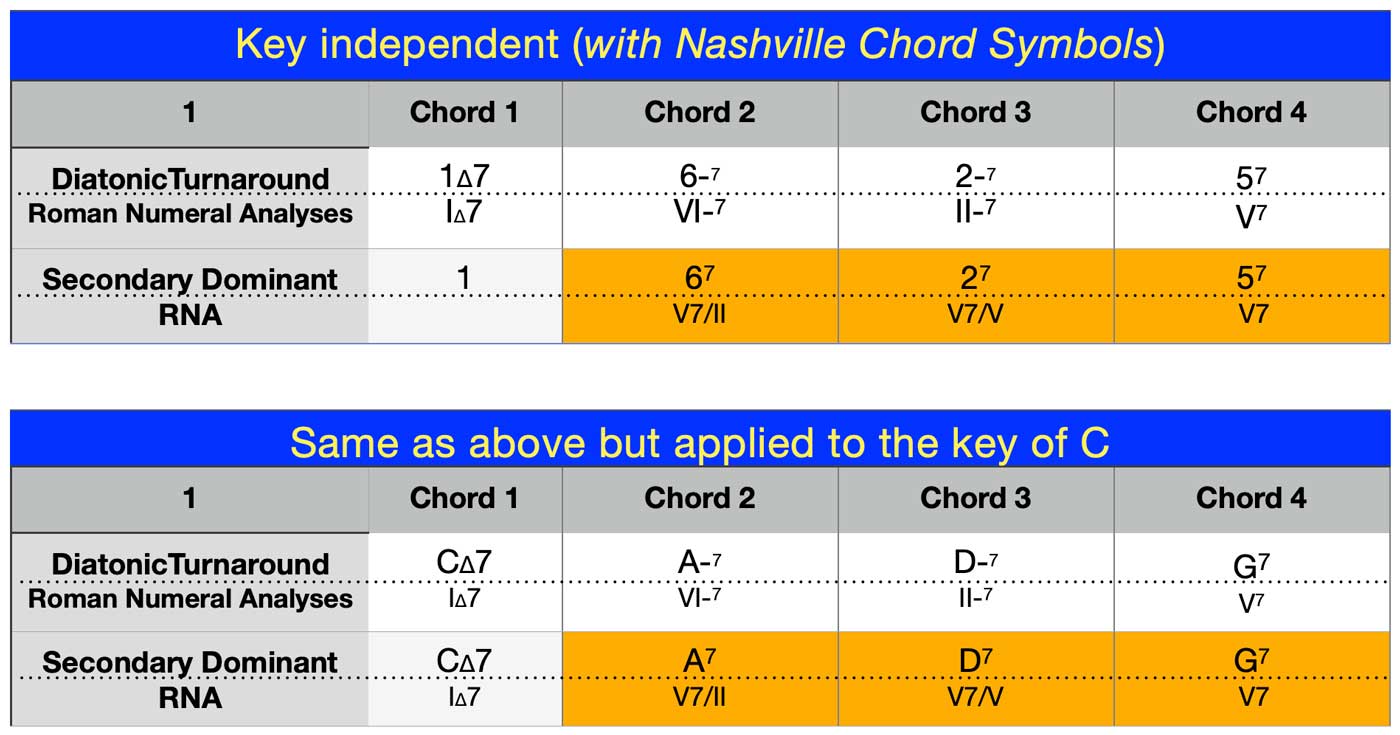What Are Secondary Dominant Chords?
The short explanation is this:
secondary dominant chords (also called Applied Chords and Secondary Chords) are chords that function as dominant chords to chords other than the tonic chord of the key.
Roman Numeral Analyses
When we encounter a secondary dominant chord, we analyze it as [Dominant Seventh Chord] of [some temporary tonic chord].
In music theory analyses we use Roman Numerals to express chordal relationships.
For example, V7/IV means, we play the dominant chord that belongs to the chord built on the 4th scale degree of the key we are in.
In the key of C, the 4th diatonic chord is F.
Now all you have to do is ask yourself this simple question: What is the dominant chord in the key of F?
C7 of course.
This means in the key of C, C7 is analyzed as V7/VI.
V7 = Secondary Dominant Chord
/ = of
VI = the tonic chord of the temporary key
Got it?
Not quite sure yet? Just keep reading.
What are secondary dominant chords used for?
Generally speaking
Secondary Dominant Chords add interest to a chord progression.
They are inherently non-diatonic to the key, which means they include chromatic alterations of the key's underlying scalar notes, thus introducing unexpected pitches.
From a theory geek's perspective
Secondary Dominant Chords are used for giving other chord more harmonic weight.
In Nerd Country this is also known as tonicization. In layman terms, we basically allow an other chord than the tonic chord of the key to play King for a day. (Well, in reality it usually only lasts for a a few seconds or less.)
Secondary Dominant Chords are also great for modulating to a new key.
In classical music and pop music Secondary Dominant Chords mostly target the diatonic chords of the key. In Jazz and modern Western music it can be any chord though.
A few examples for Secondary Dominant chords
Here are some examples in the key of C:
Examples of a jazz turnaround with secondary dominant chords
Below is a table that shows how we can use secondary dominant chords to spice up the classic diatonic jazz turnaround.

Characteristics of secondary dominant chords
Strictly speaking, in order to fit the bill, a secondary dominant chord has all the characteristics of a regular dominant chord.
The most obvious one would be that the chord's root has to be a perfect 5th above the chord it precedes, the target chord.
It also has to include the leading tone (the major third of the chord), which resolves up one half-step to become the root note of the target chord.
And then there is the minor seventh. Ah, the minor seventh. She is as beautiful as she is dominant, and she really aged well!
The minor seventh is a very important additional ingredient, and more often than not, it is present in secondary dominant chords - especially in jazz type of music.
Why the seventh?
Music harmony - much like life itself - is all about resolving dissonance and voice leading. In a V7 I∆7 chord progression, the seventh resolves down by step, and the major third up a step from the V7 to the tonic (I∆7) chord.
The devil's favorite interval
The chordal seventh and the chordal major third build an interval known as the tritone.
In the old days (1600-1700) the tritone interval was considered extremely dissonant and had to be resolved. Today, it's a whole different story.
The theory behind the tritone
The two notes of the tritone (the interval between chordal third and seventh of the dominant seventh chord) are resolved either outwards (when the seventh is placed below the third) or inwards (when the third is below the seventh), as shown below.
In both cases, the third moves up a half step into the tonic of the target chord, and the minor sevenths moves down a half-step to become the third of the target chord. When the target chord has a minor quality, the seventh moves down a whole-step.

It had to be resolved
During Mozart's time a dominant seventh chord always had to be resolved, especially at the end of a piece, because it was considered very dissonant (unstable). Today everything goes of course.
Funny Story, if you Can believe it
Here is a funny story: Mozart apparently loved to provoke his audience by ending a song with the dominant seventh chord. He then left the stage, waited a few minutes, and returned to the piano only to play the tonic chord, with a big smile on his face. (At least that's the story my brother once told me. So take it with a grain of salt!)
The best is yet to come
This post is far from done. Here are things we are adding shortly:
Please subscribe to our Newsletter (see footer section) so we can let you know when this post is finished, and about other great stuff we think you might enjoy as it relates to playing the keys.
